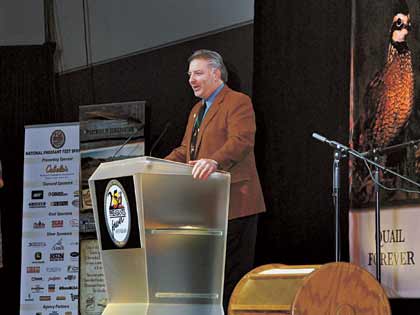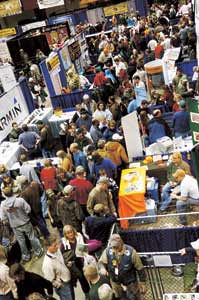Conservation's success rests on our shoulders.
By Joel Vance
 Howard Vincent, CEO of Pheasants Forever, says the organization hopes to have 200,000 members within another five years. |
Despite the grumbling about illegal immigration, we've added hundreds of thousands--actually millions--of aliens to the population. They're ornery, cantankerous, obstreperous and generally anti-social...and we've showered them with time, money and praise.
Solid-citizen Americans join a group dedicated to propagating these sneaky heathens and have chipped in $199 million and counting to primp five million acres to be attractive to these contentious invaders, and we pay even more big bucks to visit them each autumn.
I speak, of course, of the ring-necked pheasant, the rooster of which is gaudy, jaundice-eyed and born with a chip on its brightly feathered shoulder; and of Pheasants Forever, the hottest conservation group around.
"We're on a growth path now," says Howard Vincent, CEO of PF, which has 115,000 members (its offshoot Quail Forever signed up 5,000 in just two years). "We want to grow to 200,000 in the next five years. We also believe we can put another five million acres on the ground in five years.
"This year we put $38 million toward conservation. We do it one acre at a time. Those local volunteers who put those acres in their counties, in their communities, working with their youth--that's what it's about."
Pheasants Forever celebrated its 25th anniversary in January, 2008, in conjunction with its fourth annual Pheasant Fest in St. Paul, the birthplace of the organization. More than 300 exhibitors and a record 29,802 hunters, dog folks, and probably a few people trying to escape 25-below-zero windchills, gathered to celebrate the alien animal with the long tail.
Right now pheasants are on a roll, with high populations in most of the traditional pheasant states--South Dakota pre-eminent. The rowdy rooster funnels many millions of dollars into local economies in those states, but as always there are nasty omens lurking like distant storm clouds. Ethanol, the fuel-of-the-day, requires corn and corn requires a place to grow.
High corn prices inevitably encourage corn planting, which requires plowing under the weedy-grassy habitat favored by pheasants (and quail, turkeys and any other upland wildlife species). Anyone who has hunted standing corn knows how pheasants love to run around in it, never flushing. But cut that corn to ground level, fall plow the residue and throw in a January ice storm and you have the makings of a wildlife disaster.
"Corn is the hot commodity right now but it's not sustainable in anyone's thoughts," Vincent says. "If you're going to grow switchgrass for cellulosic biofuel, it would be harvested every two years. You could harvest 50 percent of your crop every year in the fall. Then you'd have some nesting cover, good water and soil protection most of the year and when you got into fall season the birds are off the nest and you wouldn't have that great an impact. We'd like to add that to the CRP as an additive process."
Pheasants Forever has an enviable record among the many conservation groups--it has gained a four-star rating from Charity Navigator, a prominent watchdog group on non-profits, four years in a row (probably five by the time this is printed). That puts PF in the top five percent of all charitable organizations, based on its ability to manage money effectively (for the benefit of its namesake cause, not the benefit of the folks who work there). This money management skill makes PF almost unique among conservation groups--the National Wild Turkey Federation and Trout Unlimited also are four-star, but the rest can only hope and try to do better.
 Nearly 30,000 people attended Pheasant Fest 2008 in St. Paul, Minnesota. The event celebrated Pheasants Forever's 25th anniversary and featured more than 300 exhibitors. |
"It's our local volunteers," Vincent says. "They raise their dollars locally and most importantly, they put the money on the ground locally. That allows us to be the most efficient conservation organization in the country."
PF has bought 127,220 acres in 1,062 land acquisitions in partnership with state wildlife agencies or the U.S. Fish & Wildlife Service. The land is opened for hunting and other compatible outdoor recreation activities. The group does its magic with a fulltime staff of fewer than four dozen people. They produce a slick magazine, have an enviable youth program and have zeroed in on family participation in, first, producing more pheasants and then in reducing many of them to gourmet fare.
The $30 membership fee for PF (or $50 for a family) is what funds 40 percent of the national organization, which includes a five-times-a-year magazine. "We have to go out and raise the other 60 percent," Vincent says. "And that's what makes us lean and mean. Again, it's our local volunteers who raise those dollars locally and, in turn, put the money on the ground locally."
Quail Forever, Vincent thinks, was inevitable. "There were PF chapters on the southern range of the pheasant that were interested in having the same model for quail--raising dollars locally and keeping them there--and we felt it was important to allow those people with passion to have an impact on that resource."
PF's muscle showed in the Fest program--the acting Department of Agriculture secretary Chuck Conner appeared to trumpet a new project called the State Acres for Wildlife Enhancement (SAFE) that will supplement the treasured Conservation Reserve Program.
States recommend habitat projects and the feds fund them. Included are 45 proposals for 260,000 acres in 18 states. Missouri has applied for nearly 20,000 acres and Illinois nearly 26,000 acres. Chances are there would be no such program if it were not for PF and the other upland conservation organizations using their lobbying muscle.
Under SAFE the Agriculture Department would pay up to 90 percent cost share for habitat restoration and 50 percent for management. Contracts run 10-15 years. There are other incentives and it's a good program, a companion to the Conservation Reserve and other conservation measures that hunters/conservationists can only hope make it into the final Farm Bill.
"We're always a vote behind.
Washington can be a fickle place and politics is king," Vincent notes. "So we recognize we're going to have to fight that battle right up to when the president signs the bill. Even after that, how do you implement those acres--that's as much a challenge as getting the bill done."
Conservationists have gotten smarter over the past few years--they're combining forces in umbrella groups like the Teddy Roosevelt Conservation Partnership and American Wildlife Conservation Partners that represent not just their membership, but the combined strength of the member groups (three million or so for the AWCP, which has about 40 member groups).
One person leaning on Congress is virtually meaningless; one group is better€¦but a bunch of groups pulling in tandem can move that unresponsive monolith known as Congress.
"We can't do this ourselves," Vincent says. "It does take partnerships and we try to forge those."
And it takes individual members within the conservation groups...lots of individual members.
That's us, folks.
Joel Vance is the author of Grandma and the Buck Deer (softcover $15); Bobs, Brush and Brittanies (hardcover $22); Tails I Lose (hardcover $25); Down Home Missouri (hardcover $25); and Autumn Shadows (limited edition $65). Available from Cedar Glade Press, Box 1664, Jefferson City MO 65102. Add $2/book for S/H.






